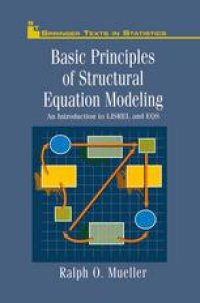
Ebook: Basic Principles of Structural Equation Modeling: An Introduction to LISREL and EQS
Author: Ralph O. Mueller PhD (auth.)
- Tags: Probability Theory and Stochastic Processes
- Series: Springer Texts in Statistics
- Year: 1996
- Publisher: Springer-Verlag New York
- Edition: 1
- Language: English
- pdf
During the last two decades, structural equation modeling (SEM) has emerged as a powerful multivariate data analysis tool in social science research settings, especially in the fields of sociology, psychology, and education. Although its roots can be traced back to the first half of this century, when Spearman (1904) developed factor analysis and Wright (1934) introduced path analysis, it was not until the 1970s that the works by Karl Joreskog and his associates (e. g. , Joreskog, 1977; Joreskog and Van Thillo, 1973) began to make general SEM techniques accessible to the social and behavioral science research communities. Today, with the development and increasing avail ability of SEM computer programs, SEM has become a well-established and respected data analysis method, incorporating many of the traditional analysis techniques as special cases. State-of-the-art SEM software packages such as LISREL (Joreskog and Sorbom, 1993a,b) and EQS (Bentler, 1993; Bentler and Wu, 1993) handle a variety of ordinary least squares regression designs as well as complex structural equation models involving variables with arbitrary distributions. Unfortunately, many students and researchers hesitate to use SEM methods, perhaps due to the somewhat complex underlying statistical repre sentation and theory. In my opinion, social science students and researchers can benefit greatly from acquiring knowledge and skills in SEM since the methods-applied appropriately-can provide a bridge between the theo retical and empirical aspects of behavioral research.
The last two decades have seen structural equation modeling (SEM) emerge as a powerful data analysis tool for research in the social sciences, education, and psychology. With the advent of SEM computer programs such as LISREL and EQS, SEM has become a well-established and respected methodology. This book provides an introduction to the subject suitable for beginning graduate students. Its focus is on the basic concepts and applications of SEM within the social and behavioral sciences. The author develops SEM techniques by presenting linear regression, path analysis, confirmatory factor analysis, and then more general structural equation models. In doing so, he is able both to explain clearly the underlying statistical methodology in SEM whilst at the same time illustrate the use of SEM to analyse real data sets drawn from a number of different settings in the behavioral and social sciences.
The last two decades have seen structural equation modeling (SEM) emerge as a powerful data analysis tool for research in the social sciences, education, and psychology. With the advent of SEM computer programs such as LISREL and EQS, SEM has become a well-established and respected methodology. This book provides an introduction to the subject suitable for beginning graduate students. Its focus is on the basic concepts and applications of SEM within the social and behavioral sciences. The author develops SEM techniques by presenting linear regression, path analysis, confirmatory factor analysis, and then more general structural equation models. In doing so, he is able both to explain clearly the underlying statistical methodology in SEM whilst at the same time illustrate the use of SEM to analyse real data sets drawn from a number of different settings in the behavioral and social sciences.
Content:
Front Matter....Pages i-xxviii
Linear Regression and Classical Path Analysis....Pages 1-61
Confirmatory Factor Analysis....Pages 62-128
General Structural Equation Modeling....Pages 129-178
Back Matter....Pages 179-231
The last two decades have seen structural equation modeling (SEM) emerge as a powerful data analysis tool for research in the social sciences, education, and psychology. With the advent of SEM computer programs such as LISREL and EQS, SEM has become a well-established and respected methodology. This book provides an introduction to the subject suitable for beginning graduate students. Its focus is on the basic concepts and applications of SEM within the social and behavioral sciences. The author develops SEM techniques by presenting linear regression, path analysis, confirmatory factor analysis, and then more general structural equation models. In doing so, he is able both to explain clearly the underlying statistical methodology in SEM whilst at the same time illustrate the use of SEM to analyse real data sets drawn from a number of different settings in the behavioral and social sciences.
Content:
Front Matter....Pages i-xxviii
Linear Regression and Classical Path Analysis....Pages 1-61
Confirmatory Factor Analysis....Pages 62-128
General Structural Equation Modeling....Pages 129-178
Back Matter....Pages 179-231
....